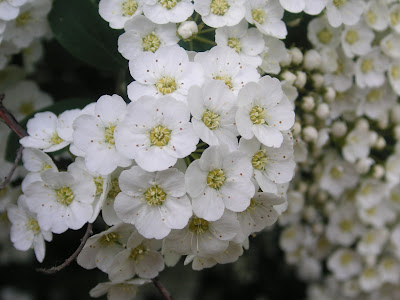Plant of the day is: Spiraea crenata or scalloped spirea
You'll notice right off the bat something that vexes me with this genus. Common name is spirea while the genus is named Spiraea. You're killin me smalls. This tough little shrub makes its appearance on account of meeting it in it's native habitat but under cultivation. You'll see a photo from my recent Russia trip. It was told to me as Spiraea litwinowii but that is, with a fair degree of confidence it seems, a synonym for Spiraea crenata.
Taxonomy etc.: I know you can guess the family from the flower right? If you guessed Rosaceae you were spot on. If not...you tried and that's the important thing. It's a pretty good sized one with around 95 genera and a bit shy of 3,000 species. Spiraea itself is a decent sized family with somewhere between 80 and 100 species, I'll let the taxonomists sort that one out. Something fun to note is that the genus used to include Filipendula and Aruncus, with Filipendula being very closely related. There are smatterings of Spiraea across the Northern Hemisphere but the greatest diversity occurs in eastern Asia, where we've obtained many of our horticultural value specimens. Worth noting that we do have a Missouri endangered Spiraea (its safe in other states). Spiraea alba is only noted in a handfull of counties in Missouri, mostly north in areas surrounding Sullivan county.
Description: Hardy deciduous shrub to 1.5m with slender arching branches. Inflorescense is umbel-like with many white flowers. Leaves are lanceolate to obovate, and entire. They can occasionally have fine toothed or scalloped leaves. Just to be sure I looked up scalloped in terms of leaf margins. Crenate. Just say crenate margin. Oye! So many words for things. Having a hard time with a good botanical description for the species BUT, here is the original published species from Species Plantarum by Carl von Linnaeus himself. S. crenata is listed as #5 and specifically notes "corymbis" which is in reference to the corymb like structure of the inflorescence which you can see from these photos. Yes, that IS a scan from the original document. Very inspiring. After a bit more of a stint in Russia, the plants are going to start going with some older explorer botanists to tell their stories as well as the plants. Looking forward to it.
Culture: Pretty cold hardy, down to zone 4. Can actually handle quite a bit of drought and full sun. Naturally found on environments as harsh as some of the steppes of Russia. Prefers stony, calcareous soils in its native habitat but is adaptable to wide range of soils. Missouri Botanical Garden website lists as flowering April to May but I certainly saw it flowering in September in Volgograd Russia. Certainly worth noting that it flowers on old wood so prune immediately after flowering BEFORE new buds have the chance to form.
Taken in Volgograd, Russia
Photo Credit: Justin Lee Creative Commons 3.0 Unported



No comments:
Post a Comment